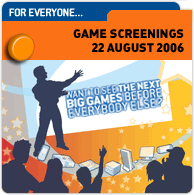
The 2004 Edge Award,
received by David Yarnton,
General Manager Nintendo UK
The EIEF06 Edge Award
The EIEF06 Edge Award aims to reward games which expand expectations of what games are capable of. Drawn from games reviewed by Edge over the past year, the shortlist rewards neither commercial success, nor necessarily popularity, but instead highlights the games which have marked out innovative new paths or achieved new standards of excellence. This shortlist is then considered by an international panel of game industry insiders: people whose professional insight into games hasn’t dimmed their personal passion for playing them.
Edge Award shortlist:
Amped 3 (360, developed by Indie Built, Inc, published by Take Two)
Just a snowboarding game? Look again. From its serious-minded roots, Amped 3 has exploded into a riot of animated comedy, delivered with a red-blooded confidence that the gaming audience is as savvy, as smart and as keen to be amused as any film or TV audience – not least because film and TV audiences //are// the gaming audience. Creative, anarchic and shamelessly un-neutered by focus-testing, Amped 3 makes it impossible to ignore how conservative and hesitant much of gaming has become.
Brain Training (DS, developed and published by Nintendo)
It’s attracted attention for its ability to attract the attention of pensioners to games, but its cross-generational appeal is only the beginning of its charms. As effective a demonstration of Nintendo’s game design experience as any Mario or Zelda classic, Brain Training may look like the worst idea for a fun five minutes ever – mental arithmetic, Dickens readings and memory tests – but it works as a case study in why good game mechanics are so compelling, whatever the framework they serve.
Dragon Quest VIII (PS2, developed by Level 5 and published by Square Enix)
Often it’s hard for games to learn from each other, their aims and techniques so different that what works for one won’t work for another. What’s remarkable about Dragon Quest VIII is that it sets a benchmark of quality that stands as an objective for all other games, regardless of their style or budget. For every component of the game, from battle dynamics to character voicing and script writing to musical scoring, nothing but excellence was tolerated by Square Enix, which leaves players wondering why they settle for other games that themselves settle for anything less.
Electroplankton (DS, developed by Toshio Iwai, published by Nintendo)
As easy an answer as we’re likely to get to the conundrum of whether or not games are art, Toshio Iwai’s exploration of what gaming hardware can offer the creative world also demonstrates what the creative world has to offer game design. Beautiful and idiosyncratic, Electroplankton shows how simple, expressive playfulness can be every bit as engrossing as a goal-oriented, competitive gaming. Its microscopic world of musical microbes is as delicate as it is diverting, and as mechanically meticulous as it is seductively unconstrained.
Fahrenheit (PC/PS2/Xbox, developed by Quantic Dream, published by Atari)
A signpost rather than a destination, Fahrenheit finally points a practical way forward for games to take inspiration from cinema, and sketches a moral framework with subtleties beyond the “Would you like to be evil: Y/N” that so often sits at the heart of ostensibly sophisticated games. Its imperfections clearly demonstrate just how challenging a journey it will be for games to take, but its emotional richness and visual impact demonstrate how valuable the rewards are which await those who tackle it.
Guitar Hero (PS2, developed by Harmonix, published by Red Octane)
For years games have chased the goal of being about what you feel rather than what you do: turns out all they needed was a guitar and a Jimi Hendrix tape. Guitar Hero, by focusing on recreating the feeling of being a rock god rather than simulating the process of being a guitarist, has changed how we think about the emotional connection players have with games. Perfectly exploiting the natural connections that playing music has with playing games, Harmonix has demonstrated a new approach which all kinds of performance games can learn from.
Killer 7 (GC/PS2, developed by Grasshopper Inc, published by Capcom)
A screenshot alone should be enough to convince this is no ordinary game. Mature, peculiar and uncompromising, its tale of a deranged clan of assassins is as unsettling as it is entertaining. Aesthetically explosive, its visual and aural inventiveness is peerless, taking advantage of its unfashionably ‘on-rails’ gameplay to create a perfectly synchronised assault of light, sound and action. The clarity with which it endures in player’s minds after they moved on to other games demonstrates how powerful its effects can be.
Ouendan (DS, developed by Inis, published by Nintendo)
Games have for decades traded on the buzz of being a bad-ass: ramming an opponent into a tyre-wall, lobbing a grenade into nest of identikit Nazis, or dissolving an enemy drone in a wash of laser fire. Ouendan relies instead on the buzz of doing good. A music game which asks you to cheer along ordinary people as they face ordinary dilemmas, there’s little to match the flush of pride and affection as you see them triumph, helped along by your encouragement. As stimulating and challenging as it is moving, Ouendan is a testament to how little most games manage to leverage the power of their stories.






















